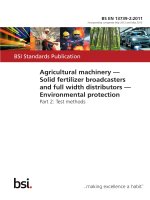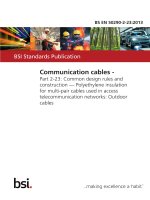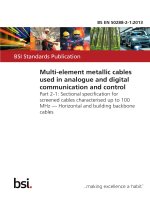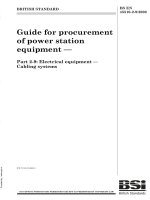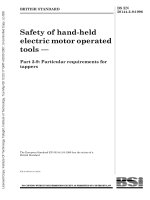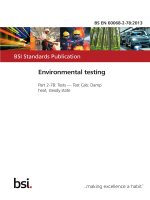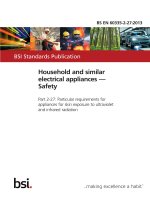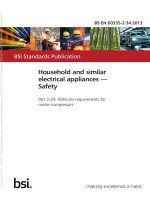Bsi bs en 61347 2 9 2013
Bạn đang xem bản rút gọn của tài liệu. Xem và tải ngay bản đầy đủ của tài liệu tại đây (1.22 MB, 36 trang )
BS EN 61347-2-9:2013
BSI Standards Publication
Lamp controlgear
Part 2-9: Particular requirements
for electromagnetic controlgear
for discharge lamps
(excluding fluorescent lamps)
BRITISH STANDARD
BS EN 61347-2-9:2013
National foreword
This British Standard is the UK implementation of EN 61347-2-9:2013.
It is identical to IEC 61347-2-9:2013. It supersedes
BS EN 61347-2-9:2001+A2:2006, which will be withdrawn on 4 December 2015.
The UK participation in its preparation was entrusted by
Technical Committee CPL/34, Lamps and Related Equipment, to
Subcommittee CPL/34/3, Auxiliaries for lamps.
A list of organizations represented on this committee can be obtained on
request to its secretary.
This publication does not purport to include all the necessary provisions of a
contract. Users are responsible for its correct application.
© The British Standards Institution 2013.
Published by BSI Standards Limited 2013.
ISBN 978 0 580 72014 7
ICS 29.140.99
Compliance with a British Standard cannot confer immunity
from legal obligations.
This British Standard was published under the authority of the
Standards Policy and Strategy Committee on 31 January 2013.
Amendments issued since publication
Amd. No.
Date
Text affected
BS EN 61347-2-9:2013
EN 61347-2-9
EUROPEAN STANDARD
NORME EUROPÉENNE
EUROPÄISCHE NORM
ICS 29.140.99
January 2013
Supersedes EN 61347-2-9:2001 + corr. Jul.2003 + corr. Dec.2010 + A1:2003 + A2:2006
English version
Lamp controlgear Part 2-9: Particular requirements for electromagnetic controlgear for
discharge lamps (excluding fluorescent lamps)
(IEC 61347-2-9:2012)
Appareillages de lampes Partie 2-9: Exigences particulières pour
les appareillages électromagnétiques pour
lampes à décharge (à l'exclusion des
lampes fluorescentes)
(CEI 61347-2-9:2012)
Geräte für Lampen Teil 2-9: Besondere Anforderungen an
elektromagnetische Betriebsgeräte für
Entladungslampen (ausgenommen
Leuchtstofflampen)
(IEC 61347-2-9:2012)
This European Standard was approved by CENELEC on 2012-12-04. CENELEC members are bound to comply
with the CEN/CENELEC Internal Regulations which stipulate the conditions for giving this European Standard
the status of a national standard without any alteration.
Up-to-date lists and bibliographical references concerning such national standards may be obtained on
application to the CEN-CENELEC Management Centre or to any CENELEC member.
This European Standard exists in three official versions (English, French, German). A version in any other
language made by translation under the responsibility of a CENELEC member into its own language and notified
to the CEN-CENELEC Management Centre has the same status as the official versions.
CENELEC members are the national electrotechnical committees of Austria, Belgium, Bulgaria, Croatia, Cyprus,
the Czech Republic, Denmark, Estonia, Finland, Former Yugoslav Republic of Macedonia, France, Germany,
Greece, Hungary, Iceland, Ireland, Italy, Latvia, Lithuania, Luxembourg, Malta, the Netherlands, Norway, Poland,
Portugal, Romania, Slovakia, Slovenia, Spain, Sweden, Switzerland, Turkey and the United Kingdom.
CENELEC
European Committee for Electrotechnical Standardization
Comité Européen de Normalisation Electrotechnique
Europäisches Komitee für Elektrotechnische Normung
Management Centre: Avenue Marnix 17, B - 1000 Brussels
© 2013 CENELEC -
All rights of exploitation in any form and by any means reserved worldwide for CENELEC members.
Ref. No. EN 61347-2-9:2013 E
BS EN 61347-2-9:2013
EN 61347-2-9:2013
Foreword
The text of document 34C/1022/FDIS, future edition 2 of IEC 61347-2-9, prepared by SC 34C, "Auxiliaries
for lamps", of IEC TC 34, "Lamps and related equipment" was submitted to the IEC-CENELEC parallel
vote and approved by CENELEC as EN 61347-2-9:2013.
The following dates are fixed:
•
•
latest date by which the document has
to be implemented at national level by
publication of an identical national
standard or by endorsement
latest date by which the national
standards conflicting with the
document have to be withdrawn
(dop)
2013-09-04
(dow)
2015-12-04
This document supersedes EN 61347-2-9:2001 + corr. Jul.2003 + corr. Dec.2010 + A1:2003 + A2:2006.
EN 61347-2-9:2013 includes the following significant technical changes with respect to EN 61347-29:2001:
a) the addition of a new Clause 14;
b) the word "ballast" is changed to "electromagnetic controlgear".
This standard shall be used in conjunction with EN 61347-1.
This Part 2-9 supplements or modifies the corresponding clauses in EN 61347-1, so as to convert that
publication into the European Standard: Particular requirements for electromagnetic controlgear for
discharge lamps (excluding fluorescent lamps).
Where the requirements of any of the clauses of EN 61347-1 are referred to in this standard by the
phrase "The requirements of clause n of EN 61347-1 apply", this phrase is interpreted as meaning that all
requirements of the clause in question of Part 1 apply, except any which are clearly inapplicable to the
specific type of lamp controlgear covered by this particular part of EN 61347-2.
NOTE In this standard, the following print types are used:
– Requirements proper: in roman type.
– Test specifications: in italic type.
– Explanatory matter: in smaller roman type.
Attention is drawn to the possibility that some of the elements of this document may be the subject of
patent rights. CENELEC [and/or CEN] shall not be held responsible for identifying any or all such patent
rights.
This standard covers the Principle Elements of the Safety Objectives for Electrical Equipment Designed
for Use within Certain Voltage Limits (LVD - 2006/95/EC).
BS EN 61347-2-9:2013
EN 61347-2-9:2013
Endorsement notice
The text of the International Standard IEC 61347-2-9:2012 was approved by CENELEC as a European
Standard without any modification.
In the official version, for Bibliography, the following notes have to be added for the standards indicated:
IEC 60923
NOTE Harmonized as EN 60923.
IEC 61167
NOTE Harmonized as EN 61167.
IEC 61347-2-8
NOTE Harmonized as EN 61347-2-8.
BS EN 61347-2-9:2013
EN 61347-2-9:2013
Annex ZA
(normative)
Normative references to international publications
with their corresponding European publications
The following documents, in whole or in part, are normatively referenced in this document and are
indispensable for its application. For dated references, only the edition cited applies. For undated
references, the latest edition of the referenced document (including any amendments) applies.
NOTE When an international publication has been modified by common modifications, indicated by (mod), the relevant EN/HD
applies.
Publication
Year
Title
EN/HD
Year
IEC 60188
-
High-pressure mercury vapour lamps Performance specifications
EN 60188
-
IEC 60192
-
Low pressure sodium vapour lamps Performance specifications
EN 60192
-
IEC 60598-1
-
Luminaires Part 1: General requirements and tests
EN 60598-1
-
IEC 60662
-
High pressure sodium vapour lamps Performance specifications
EN 60662
-
IEC 61347-1 (mod) 2007
+ A1
2010
Lamp controlgear Part 1: General and safety requirements
EN 61347-1
+ A1
2008
2011
IEC 61347-2-1
-
Lamp controlgear Part 2-1: Particular requirements for starting
devices (other than glow starters)
EN 61347-2-1
-
IEC 62035 (mod)
-
Discharge lamps (excluding fluorescent
lamps) - Safety specifications
EN 62035
-
BS EN 61347-2-9:2013
61347-2-9 © IEC:2012
CONTENTS
INTRODUCTION . .................................................................................................................................. 6
1
Scope . ............................................................................................................................................. 7
2
Normative references . .................................................................................................................. 7
3
Terms and definitions . .................................................................................................................. 7
4
General requirements . .................................................................................................................. 8
5
4.1 General ................................................................................................................................. 8
4.2 Capacitors and other components .................................................................................... 8
4.3 Thermally protected electromagnetic controlgear . .......................................................... 8
General notes on tests . ................................................................................................................ 8
6
Classification . ................................................................................................................................. 9
7
Marking . .......................................................................................................................................... 9
8
7.1 General ................................................................................................................................. 9
7.2 Mandatory markings . .......................................................................................................... 9
7.3 Information to be provided, if applicable .......................................................................... 9
7.4 Other information . ............................................................................................................... 9
Protection against accidental contact with live parts . ............................................................ 10
9
Terminals . .................................................................................................................................... 10
10 Provisions for earthing . ............................................................................................................... 10
11 Moisture resistance and insulation ............................................................................................ 10
12 Electric strength . ......................................................................................................................... 10
13 Thermal endurance test for windings . ...................................................................................... 10
14 Electromagnetic controlgear heating . ....................................................................................... 10
14.1 General . ............................................................................................................................. 10
14.2 Test requirements ............................................................................................................. 10
14.3 Normal operating condition . ............................................................................................. 11
14.4 Abnormal operating condition . ........................................................................................ 11
15 High-voltage impulse testing ...................................................................................................... 14
15.1 General . ............................................................................................................................. 14
15.2 Test for electromagnetic controlgear operating with lamp with external
starting devices . ................................................................................................................ 14
15.3 Test for electromagnetic controlgear operating with lamps with internal
starting devices . ................................................................................................................ 14
16 Fault conditions . .......................................................................................................................... 16
17 Construction ................................................................................................................................. 16
18 Creepage distances and clearances . ....................................................................................... 16
19 Screws, current-carrying parts and connections . .................................................................... 16
20 Resistance to heat, fire and tracking . ....................................................................................... 16
21 Resistance to corrosion .............................................................................................................. 16
22 No-load output voltage ............................................................................................................... 16
Annex A (normative) Test to establish whether a conductive part is a live part which
may cause an electric shock ............................................................................................................. 17
Annex B (normative) Particular requirements for thermally protected lamp
electromagnetic controlgear .............................................................................................................. 18
BS EN 61347-2-9:2013
61347-2-9 © IEC:2012
Annex C (normative) Particular requirements for electronic lamp controlgear with
means of protection against overheating . ....................................................................................... 19
Annex D (normative) Requirements for carrying out the heating tests of thermally
protected lamp electromagnetic controlgear ................................................................................... 20
Annex E (normative) Use of constant S other than 4 500 in t w tests . ........................................ 21
Annex F (normative) Draught-proof enclosure . ............................................................................. 22
Annex G (normative) Explanation of the derivation of the values of pulse voltages . .............. 23
Annex H (normative) Tests............................................................................................................... 24
Annex I (normative) Method for selection of varistors .................................................................. 25
Annex J (informative) Explanation of electromagnetic controlgear temperatures . .................. 26
Annex K (normative) Additional requirements for built-in electromagnetic controlgear
with double or reinforced insulation . ................................................................................................ 29
Bibliography ......................................................................................................................................... 30
Figure 1 – Test circuit for electromagnetic controlgear for lamps with integral starting devices
. ............................................................................................................................................................. 15
Figure J.1 – Test hood for electromagnetic controlgear heating test . ......................................... 28
Figure J.2 – Test corner for electromagnetic controlgear heating . ............................................. 28
Table 1 – Test voltages for electromagnetic controlgear generating pulse voltages . .............. 10
Table 2 – Maximum temperatures . .................................................................................................. 12
Table 3 – Limiting temperatures of windings under abnormal operating conditions and
at 110 % of rated voltage for electromagnetic controlgear subjected to endurance test duration of 30
days ...................................................................................................................................................... 13
Table 4 – Limiting temperatures of windings under abnormal operating conditions and
at 110 % of rated voltage for electromagnetic controlgear marked D6 which are
subjected to an endurance test duration of 60 days . ................................................................... 13
BS EN 61347-2-9:2013
–6–
61347-2-9 © IEC:2012
INTRODUCTION
This second edition of IEC 61347-2-9 is published in conjunction with IEC 61347-1. The
formatting into separately published parts provides for ease of future amendments and
revisions. Additional requirements will be added as and when a need for them is recognized.
This standard, and the parts which make up IEC 61347-2, in referring to any of the clauses of
IEC 61347-1, specify the extent to which such a clause is applicable and the order in which
the tests are to be performed; they also include additional requirements, as necessary. All
parts which make up IEC 61347-2 are self-contained and, therefore, do not include references
to each other.
BS EN 61347-2-9:2013
61347-2-9 © IEC:2012
–7–
LAMP CONTROLGEAR –
Part 2-9: Particular requirements for electromagnetic
controlgear for discharge lamps (excluding fluorescent lamps)
1
Scope
This part of the IEC 61347 series specifies particular safety requirements for electromagnetic
controlgear for discharge lamps such as high-pressure mercury vapour, low-pressure sodium
vapour, high-pressure sodium vapour and metal halide lamps. The standard covers inductivetype electromagnetic controlgear for use on a.c. supplies up to 1 000 V at 50 Hz or 60 Hz,
associated with discharge lamps, having rated wattages, dimensions and characteristics as
specified in IEC 60188, IEC 60192 and IEC 60662.
This standard applies to complete electromagnetic controlgear and to their component parts
such as reactors, transformers and capacitors. Particular requirements for thermally protected
electromagnetic controlgear are given in Annex B.
For certain types of discharge lamps, an ignitor is required.
NOTE Electromagnetic controlgear for fluorescent lamps are covered by IEC 61347-2-8.
Performance requirements are the subject of IEC 60923.
2
Normative references
The following documents, in whole or in part, are normatively referenced in this document and
are indispensable for its application. For dated references, only the edition cited applies. For
undated references, the latest edition of the referenced document (including any
amendments) applies.
IEC 60188, High-pressure mercury vapour lamps – Performance specifications
IEC 60192, Low-pressure sodium vapour lamps – Performance specifications
IEC 60598-1, Luminaires – Part 1: General requirements and tests
IEC 60662, High-pressure sodium vapour lamps – Performance specifications
IEC 61347-1:2007, Lamp
Amendment 1:2010
controlgear
–
Part 1:
General
and
safety
requirements
IEC 61347-2-1, Lamp controlgear – Part 2-1: Particular requirements for starting devices
(other than glow starters)
IEC 62035, Discharge lamps (excluding fluorescent lamps) – Safety specifications
3
Terms and definitions
For the purpose of this document, the terms and definitions given in IEC 61347-1:2007,
together with the following apply:
BS EN 61347-2-9:2013
–8–
61347-2-9 © IEC:2012
3.1
rated temperature rise of an electromagnetic controlgear winding
∆t
temperature rise assigned by the manufacturer under the conditions specified in this standard
Note 1 to entry: The specifications for the supply and mounting conditions of the electromagnetic controlgear are
given in Annex H.
3.2
high-voltage impulse
intentionally applied periodic transient voltage which rises rapidly to a peak value and then
falls, usually less rapidly, to zero
Note 1 to entry: The term "impulse" is to be distinguished from the term "surge", which refers to transients
occurring in electrical equipment or networks in service.
Note 2 to entry: Such an impulse is, in general, well represented by the sum of two exponentials.
4
4.1
General requirements
General
The requirements of Clause 4 of IEC 61347-1:2007 apply, together with the following
additional requirements:
4.2
Capacitors and other components
Capacitors and other components incorporated in electromagnetic controlgear shall comply
with the requirements of the appropriate IEC standard.
4.3
Thermally protected electromagnetic controlgear
Thermally protected electromagnetic controlgear shall comply with the requirements of
Annex B.
5
General notes on tests
The requirements of Clause 5 of IEC 61347-1:2007 apply, together with the following
additional requirements:
The type test is carried out on one sample consisting of eight electromagnetic controlgear
submitted for the purpose of the type test. Seven electromagnetic controlgear are for the
endurance test and one for all other tests. For conditions of compliance for the endurance
test, see Clause 13.
In addition, six electromagnetic controlgear are required for the high-voltage impulse testing
according to Clause 15 below, for electromagnetic controlgear for metal halide and highpressure sodium lamps. There shall be no failure during the test.
The tests are made under the conditions specified in Annex H of IEC 61347-1:2007. In
general, all the tests are carried out on each type of electromagnetic controlgear or, where a
range of similar electromagnetic controlgear is involved, on each rated power in the range, or
on a representative selection from the range as agreed with the manufacturer. A reduction in
the number of samples for the endurance test according to Clause 13 and including the use of
constant S other than 4 500 as shown in Annex E, or even the omission of these tests, is
allowed when electromagnetic controlgear of the same construction but with different
characteristics are submitted together for approval, or when test reports from the
manufacturer or other authority are accepted by the testing station.
BS EN 61347-2-9:2013
61347-2-9 © IEC:2012
6
–9–
Classification
The requirements of Clause 6 of IEC 61347-1:2007 apply.
7
Marking
7.1
General
Electromagnetic controlgear which form an integral part of the luminaire need not be marked.
For electromagnetic controlgear intended to be mounted in the base compartment of a
column, all necessary markings according to 7.2 and 7.3 shall be on the electromagnetic
controlgear. The requirements of 7.2 of IEC 61347-1:2007 apply.
7.2
Mandatory markings
Electromagnetic controlgear, other than integral electromagnetic controlgear, shall be clearly
and durably marked with the following mandatory markings:
–
items a), b), e), f), g) and r) of 7.1 of IEC 61347-1:2007, together with:
–
in the case of electromagnetic controlgear intended to be used with ignitors
(IEC 61347-2-1), the terminals/terminations subjected to the pulse voltage shall be marked
on the electromagnetic controlgear.
This marking may be in the form of a wiring diagram. Simple reactor electromagnetic
controlgear which have several uses, for example, for controlling high-pressure mercury
vapour lamps, certain metal halide lamps, etc., need not be marked in this way.
7.3
Information to be provided, if applicable
In addition to the above mandatory markings, the following information, if applicable, shall be
given either on the electromagnetic controlgear, or be made available in the manufacturer’s
catalogue or similar.
–
Items c), h), i), j), k), o), p) and q) of 7.1 of IEC 61347-1:2007, together with:
–
for electromagnetic controlgear for use with high-pressure sodium vapour or metal
halide lamps:
1) the maximum peak value of the pulse voltage to which the electromagnetic
controlgear can be subjected if this value exceeds 1 500 V;
2) the catalogue reference of
electromagnetic controlgear.
the
ignitor(s)
which
may
be
used
with
the
–
In the case of an electromagnetic controlgear consisting of more than one separate unit,
the current-controlling inductive element(s) marked with the essential details of the other
unit(s) and/or essential capacitors.
–
In the case of an inductive electromagnetic controlgear used with a separate series
capacitor other than a radio interference suppression capacitor, repetition of the marking
of rated voltage, capacitance and tolerance.
–
Advice to the installer to prevent overheating of electromagnetic controlgear and
associated components in a multi-electromagnetic controlgear installation mounted in
poles, boxes, etc.
7.4
Other information
Manufacturers may provide the following non-mandatory information, if available:
–
the rated temperature rise of the winding following the symbol ∆t, values increasing in
multiples of 5 K.
BS EN 61347-2-9:2013
– 10 –
8
61347-2-9 © IEC:2012
Protection against accidental contact with live parts
The requirements of Clause 10 of IEC 61347-1:2007 apply.
9
Terminals
The requirements of Clause 8 of IEC 61347-1:2007 apply.
10 Provisions for earthing
The requirements of Clause 9 of IEC 61347-1:2007, Amendment 1:2010 apply.
11 Moisture resistance and insulation
The requirements of Clause 11 of IEC 61347-1:2007, Amendment 1:2010 apply.
12 Electric strength
The requirements of Clause 12 of IEC 61347-1:2007 apply.
Additionally for electromagnetic controlgear using ignitors where the pulse voltage is
generated within the electromagnetic controlgear an electric strength test shall be conducted
across insulation barriers subject to the ignition voltage. The test voltages are specified in
Table 1.
Table 1 – Test voltages for electromagnetic
controlgear generating pulse voltages
Pulse voltage ≤ 4 U × 1,414
Pulse voltage > 4 U × 1,414
Double or reinforced insulation
4 U + 2 750 V
U pmax/1,414 + 2 750 V
Basic or supplementary insulation
2 U + 1 000 V
U pmax/2 × 1,414 + 1 000 V
13 Thermal endurance test for windings
The requirements of Clause 13 of IEC 61347-1:2007 apply.
14 Electromagnetic controlgear heating
14.1 General
Electromagnetic controlgear, or their mounting surfaces, shall not attain a temperature which
would impair safety.
Compliance is checked by the tests of 14.1 to 14.3 and H.12 of IEC 61347-1:2007.
14.2 Test requirements
When the electromagnetic controlgear is tested in accordance with the requirements of 14.2
and 14.3, the temperature shall not exceed the appropriate values given in Table 2 for the test
under normal and abnormal conditions.
BS EN 61347-2-9:2013
61347-2-9 © IEC:2012
– 11 –
Before the test, the following shall be checked and measured:
a) the electromagnetic controlgear shall start and operate the lamp(s) normally;
b) the resistance of each winding shall be measured, if required, at the ambient temperature.
After this heating test, the electromagnetic controlgear shall be allowed to cool to room
temperature and then shall comply with the following conditions:
c) the electromagnetic controlgear marking shall still be legible;
d) the electromagnetic controlgear shall withstand without damage a dielectric strength test
according to Clause 12, the test voltage, however, being reduced to 75 % of the value
given in Table 1 of IEC 61347-1:2007, but not less than 500 V.
14.3
Normal operating condition
For the test under normal conditions, electromagnetic controlgear are operated with
appropriate lamps which are placed in such a way that the heat generated does not contribute
to the heating of the electromagnetic controlgear. Lamps are deemed to be appropriate if they
pass, under the prescribed test conditions, a current within the tolerances of the current a
reference lamp would pass.
The winding temperature t w with declared temperature rise ∆t of the winding, the temperature
of capacitors and other parts listed in Table 2 if used with the electromagnetic controlgear
shall not exceed the values according to Table 2.
Electromagnetic controlgear windings with temperature rise ∆t are tested under normal
conditions with the following details:
–
100 % of rated voltage and at rated frequency,
–
until steady temperature is attained.
Capacitors and parts listed in Table 2 are tested under normal conditions with the following
details:
–
106 % of rated voltage and at rated frequency,
–
until steady temperature is attained.
14.4
Abnormal operating condition
The abnormal operating conditions test is only required for electromagnetic controlgear for
some metal halide lamps and some high pressure sodium vapour lamps which, according to
the lamp safety standard IEC 62035, can lead to electromagnetic controlgear overloading.
For electromagnetic controlgear designed in accordance to Annex B of IEC 61347-1:2007,
Amendment 1:2010 the abnormal test is not required.
The abnormal operating tests for electromagnetic controlgear are only required in the built-in
situation in the luminaires and they are a part of the luminaires verifications. The tests for
abnormal circuit conditions are described in IEC 60598-1, Annex C.
Table 3 and Table 4 represent the context between the constants S and the limiting
temperature for different winding temperatures t w . Table 3 stands for the endurance test
duration of 30 days and Table 4 for the endurance test duration of 60 days.
BS EN 61347-2-9:2013
– 12 –
61347-2-9 © IEC:2012
Table 2 – Maximum temperatures
Maximum temperature
°C
Parts
Electromagnetic controlgear winding
Normal
operation at
100 % of rated
voltage
Normal
operation at
106 % of rated
voltage
Abnormal
operation at
110 % of rated
voltage
tw
-
-
∆t a
-
-
Electromagnetic controlgear winding
-
-
limiting
temperature t w
according to
Table 3
with declared temperature rise ∆t under abnormal
conditions
-
-
∆t ab b
without temperature declaration
-
50
-
with indication of t c
-
tc
-
with declared temperature rise ∆t
Electromagnetic controlgear case adjacent to
capacitor, if any (incorporated in electromagnetic
controlgear enclosure)
-
Parts made of
-
wood-filled phenolic mouldings
-
110
-
-
mineral-filled phenolic mouldings
-
145
-
-
urea mouldings
-
90
-
-
melamine mouldings
-
100
-
-
laminated, resin-bonded paper
-
110
-
-
rubber
-
70
-
-
thermoplastic materials
-
c
-
If materials or manufacturing methods are used other than those indicated in the table; they shall not be operated
at temperatures higher than those which are proved to be permissible for those materials.
The temperatures in this table shall not be exceeded when the electromagnetic controlgear is operated at its
maximum declared ambient temperature. The values in the table are based on an ambient temperature of 25 °C.
a
The measurement of the temperature rise of the windings under normal conditions at 100 % of rated voltage,
i.e. verification of a declared value so as to provide information for luminaire design, is non-mandatory and its
measurement is only performed when marked on the electromagnetic controlgear or otherwise claimed in the
catalogue.
b
This measurement is only mandatory for circuits which may produce abnormal conditions. The declared limiting
temperature of the windings under abnormal conditions (if any) is not measured but should correspond to a
number of days at least equal to two-thirds of the theoretical endurance test period so as to provide information
for luminaire design (see Table 3).
c
The temperature of thermoplastic material, other than that used for the insulation of the wiring, which provides
protection against contact with live parts or supporting such parts, is also measured. Values thus obtained
serve to establish the conditions of the test of 18.1 of IEC 61347-1:2007.
BS EN 61347-2-9:2013
61347-2-9 © IEC:2012
– 13 –
Table 3 – Limiting temperatures of windings under abnormal operating
conditions and at 110 % of rated voltage for electromagnetic controlgear
subjected to endurance test duration of 30 days
Constant S
For t w =
Limiting temperature
°C
S4,5
S5
S6
S8
S11
S16
90
171
161
147
131
119
110
95
178
168
154
138
125
115
100
186
176
161
144
131
121
105
194
183
168
150
137
126
110
201
190
175
156
143
132
115
209
198
181
163
149
137
120
217
205
188
169
154
143
125
224
212
195
175
160
149
130
232
220
202
182
166
154
135
240
227
209
188
172
160
140
248
235
216
195
178
166
145
256
242
223
201
184
171
150
264
250
230
207
190
177
Table 4 – Limiting temperatures of windings under abnormal operating conditions
and at 110 % of rated voltage for electromagnetic controlgear marked D6 which are
subjected to an endurance test duration of 60 days
Constant S
For t w =
Limiting temperature
°C
S4,5
S5
S6
S8
S11
S16
90
158
150
139
125
115
107
95
165
157
145
131
121
112
100
172
164
152
137
127
118
105
179
171
158
144
132
123
110
187
178
165
150
138
129
115
194
185
171
156
144
134
120
201
192
178
162
150
140
125
208
199
184
168
155
145
130
216
206
191
174
161
151
135
223
213
198
180
167
156
140
231
220
204
186
173
162
145
238
227
211
193
179
168
150
246
234
218
199
184
173
BS EN 61347-2-9:2013
– 14 –
61347-2-9 © IEC:2012
15 High-voltage impulse testing
15.1
General
Electromagnetic controlgear for metal halide and those for high-pressure sodium vapour
lamps, which are intended for circuits in which high-voltage impulses occur on the
electromagnetic controlgear, shall be subjected to the test of either 15.2 or 15.3 below.
Electromagnetic controlgear designed for operating in a circuit with a starting device external
to the lamp shall be subjected to the test of 15.2.
Electromagnetic controlgear designed for operating lamps with an internal starting device
shall be subjected to the test of 15.3. The manufacturer shall state which test his product has
undergone.
15.2
Test for electromagnetic controlgear operating with lamp with external starting
devices
With a load capacitance of 20 pF, the six electromagnetic controlgear mentioned in Clause 5
are operated with the ignitor and the impulse voltage measured. The ignitor is then removed
and the dielectric strength of components subjected to impulse voltage is then tested as
follows.
The electromagnetic controlgear is operated with another similar ignitor at 1,1 times the rated
voltage, without load capacitance and without a lamp, for a period of 30 days. Should the
ignitor break down before the 30 days have elapsed, it shall be replaced as often as
breakdown occurs until the test duration of 30 days has been completed.
Electromagnetic controlgear which are marked for exclusive use with an ignitor having a timedelay device (see 7.2), are subjected to the same test, but for a period consisting of
250 on/off cycles, keeping an off period of at least 2 min.
Following this test, the voltage test of Clause 12 is carried out whereby the individual
terminations, with the exception of the earthing conductor, are connected with each other. In
doing so, no sparkover or flashover shall occur. The impulse voltage is then measured again
with the original ignitor and the same load capacitance of 20 pF. Deviation from the original
value shall not be more than 10 %.
15.3
Test for electromagnetic controlgear operating with lamps with internal starting
devices
Using the six samples in 5.1, three samples are subjected to the moisture resistance and
dielectric strength test specified in Clauses 11 and 12, respectively.
The remaining three samples are heated in an oven until they attain the t w rating temperature
marked on the electromagnetic controlgear.
Immediately following these pre-conditioning tests, all six samples shall withstand the highvoltage impulse test.
The electromagnetic controlgear under test, together with a variable resistor and a suitable
circuit-breaker with a pull-in time (bounce time excluded) between 3 ms and 15 ms (for
example, a vacuum switch type H16 or VR 312/412), is connected by a d.c. supply in such a
way that, by adjusting the current and operating the circuit-breaker, voltage pulses will be
induced in the electromagnetic controlgear. The current is then adjusted slowly, increasing so
that the peak voltage marked on the electromagnetic controlgear is reached. The
measurement of the voltage pulses is made directly at the electromagnetic controlgear
terminations and in accordance with Figure 1.
BS EN 61347-2-9:2013
61347-2-9 © IEC:2012
– 15 –
If electronic circuit-breakers with a very short pull-in time are used, care should be taken
against producing a highly induced pulse voltage.
The value of the d.c. current at which the starting voltage is reached is noted. The samples
are then operated with this current for 1 h and the current is interrupted during this time, 10
times for 3 s within every minute.
Immediately after the test, all six electromagnetic controlgear shall withstand the moisture
resistance and dielectric strength test specified in Clauses 11 and 12, respectively.
NOTE
The use of this test for electromagnetic controlgear other than of the simple reactor type is under
consideration.
D3
kV
C2
Va
3
R2
+
2
4
1
P
A
+
R1
C1
C3
S
D2
25 V
D1
–
–
IEC 1987/12
Key
1
ammeter for measuring the d.c. current
2
electrostatic voltmeter with a self-capacitance not exceeding 30 pF for measuring the pulse voltage
3
protection circuit for the power supply
4
switching unit for the vacuum switch
Components
C 1 0,66 µF
C 2 5 000 pF
C 3 50 pF
D 1 diode ZD22
D 2 diode IN 4004
D 3 diode (six pieces) BYV96E
P
test sample
R 1 adjustable resistor (approximately 100 Ω)
R 2 adjustable resistor R 2 = electromagnetic controlgear × 20
S
vacuum switch
Va varistor (for selection, see Annex D)
Figure 1 – Test circuit for electromagnetic controlgear
for lamps with integral starting devices
BS EN 61347-2-9:2013
– 16 –
61347-2-9 © IEC:2012
16 Fault conditions
The requirements of Clause 14 of IEC 61347-1:2007, Amendment 1:2010 are not applicable.
17 Construction
The requirements of Clause 15 of IEC 61347-1:2007 apply.
18 Creepage distances and clearances
The requirements of Clause 16 of IEC 61347-1:2007 apply, together with the following
additional requirement.
In open-core electromagnetic controlgear, enamel, or similar material, which forms the
insulation for a wire and withstands the voltage test for grade 1 or grade 2 of IEC 60317-0-1
(Clause 13) is judged to contribute 1 mm to the values given in Tables 3 and 4 of
IEC 61347-1:2007 between enamelled wires of different windings or from enamelled wire to
covers, iron cores, etc. However, this applies only in the situation where creepage distances
and clearances are not less than 2 mm in addition to the enamelled layers.
19 Screws, current-carrying parts and connections
The requirements of Clause 17 of IEC 61347-1:2007 apply.
20 Resistance to heat, fire and tracking
The requirements of Clause 18 of IEC 61347-1:2007 apply.
21 Resistance to corrosion
The requirements of Clause 19 of IEC 61347-1:2007 apply.
22 No-load output voltage
The requirements of Clause 20 of IEC 61347-1:2007 apply.
BS EN 61347-2-9:2013
61347-2-9 © IEC:2012
– 17 –
Annex A
(normative)
Test to establish whether a conductive part is
a live part which may cause an electric shock
The requirements of Annex A of IEC 61347-1:2007 apply.
BS EN 61347-2-9:2013
– 18 –
61347-2-9 © IEC:2012
Annex B
(normative)
Particular requirements for thermally protected
lamp electromagnetic controlgear
The requirements of Annex B of IEC 61347-1:2007, Amendment 1:2010 apply, together with
the following additional requirement.
For type test purposes, specially prepared samples shall be supplied by the electromagnetic
controlgear manufacturer.
BS EN 61347-2-9:2013
61347-2-9 © IEC:2012
– 19 –
Annex C
(normative)
Particular requirements for electronic lamp controlgear
with means of protection against overheating
The requirements of Annex C of IEC 61347-1:2007 are not applicable.
BS EN 61347-2-9:2013
– 20 –
61347-2-9 © IEC:2012
Annex D
(normative)
Requirements for carrying out the heating tests
of thermally protected lamp electromagnetic controlgear
The requirements of Annex D of IEC 61347-1:2007 apply.
BS EN 61347-2-9:2013
61347-2-9 © IEC:2012
– 21 –
Annex E
(normative)
Use of constant S other than 4 500 in tw tests
The requirements of Annex E of IEC 61347-1:2007 apply.
BS EN 61347-2-9:2013
– 22 –
Annex F
(normative)
Draught-proof enclosure
The requirements of Annex F of IEC 61347-1:2007 apply.
61347-2-9 © IEC:2012
